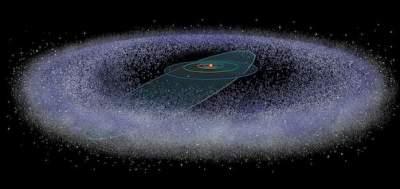The object discovered by the researchers from several institutions in Israel and the USA is about half a kilometer in size, and it is located at a distance of about 45 astronomical units from the sun. The discovery was made using the positioning device of the Hubble Space Telescope

An American-Israeli team of researchers discovered an object in the Kuiper Belt that is less than a kilometer in size. The discovery is published in the December 17, 2009 issue of Nature. The fact that so far researchers have only discovered one such object suggests that the large objects in the Kuiper Belt are destroyed by collisions.
The Kuiper belt is at the far edge of the solar system, and it extends beyond the orbit of the planet Neptune, at a distance of between 30 and 50 astronomical units (an astronomical unit = about 150 million km, the distance between the Earth and the Sun). The belt consists of objects made of rocks and ice, which are considered remnants of the early solar system. Objects in the Kuiper belt that are less than a kilometer in size cannot be observed directly with a telescope. However, they can in principle be detected when they obscure distant stars. Discoverys of such objects have already been reported in the past, but these discoveries were not considered very reliable due to various problems in the measurement process and the results themselves.
In the current study, the researchers, led by research student Hilka Schlichting, from the California Institute of Technology (Caltech), used an archival database of the FGS (Fine Guidance Sensors), one of the instruments mounted on the Hubble Space Telescope. The main purpose of the device is engineering: the device observes pre-selected stars in order to enable precise alignment of the main telescope. Over the years a large pool of these auxiliary observations has accumulated. What is special about these observations is the high observation rate, about 40 measurements per second, a rate that is particularly suitable for detecting events of obscuration by objects in the Kuiper belt, which last only a tenth of a second or even less. Schlichting and her colleagues scanned the database in search of the characteristic signature of such events. The search method is particularly suitable for discovering objects in the Kuiper Belt that are several hundred meters in size.
The object discovered by the researchers is about half a kilometer in size, and it is located at a distance of about 45 astronomical units from the sun. So far, the researchers have scanned data accumulated over about 4.5 years. The fact that so far they have discovered only one event of occultation confirms theories that the smaller objects in the Kuiper belt are destroyed by collisions, a process that is also suitable to explain observations of material around other stars.
Five Israeli researchers are partners in the research: Prof. Ram Seri from the Hebrew University (supervisor of Hilka Schlichting's doctoral thesis), Dr. Eran Ofek from the California Institute of Technology, Dr. Avishi Gal-Yam from the Weizmann Institute of Science, Prof. Shai Zucker from Tel Aviv University and Prof. Mario Livio from the Hubble Space Telescope Scientific Institute.

5 תגובות
Itzik,
So what did we really want to say?
A crescent as our gentlemen slept with a beehive
in their Foggy stories
That's the point.
No, it's the dog's bone
But the dog died a long time ago.
Well, that's the point
Crescent, the bone is unidentified
.
The mother spacecraft that sends aliens from time to time..or just an asteroid in orbit :)
What bone is it about?